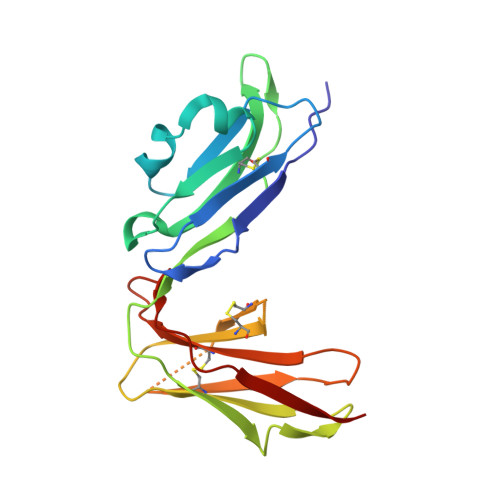Extensive polymorphisms of LILRB1 (ILT2, LIR1) and their association with HLA-DRB1 shared epitope negative rheumatoid arthritis.
Kuroki, K., Tsuchiya, N., Shiroishi, M., Rasubala, L., Yamashita, Y., Matsuta, K., Fukazawa, T., Kusaoi, M., Murakami, Y., Takiguchi, M., Juji, T., Hashimoto, H., Kohda, D., Maenaka, K., Tokunaga, K.(2005) Hum Mol Genet 14: 2469-2480
- PubMed: 16014635
- DOI: https://doi.org/10.1093/hmg/ddi247
- Primary Citation of Related Structures:
1UGN - PubMed Abstract:
Leukocyte immunoglobulin-like receptor subfamily B member 1 (LILRB1/LIR1/ILT2) is an inhibitory receptor broadly expressed on leukocytes and recognizes HLA-class I and human cytomegalovirus UL18. LILRB1 is encoded within the leukocyte receptor complex on 19q13.4, previously implicated to be a susceptibility region to systemic lupus erythematosus (SLE). In this study, we screened for polymorphisms of LILRB1 and examined their association with SLE and rheumatoid arthritis (RA). In the 5' portion of LILRB1, three haplotypes containing four non-synonymous substitutions within the ligand-binding domains and two single nucleotide polymorphisms within the promoter region were identified and designated as PE01-03. In the 3' portion, two haplotypes (CY01, 02) containing a non-synonymous substitution of the cytoplasmic region were identified. CY01 and 02 did not co-segregate with PE01-03. Significant association with susceptibility to SLE or RA was not observed; however, among the subjects not carrying RA-associated HLA-DRB1 shared epitope (SE), LILRB1.PE01/01 diplotype was significantly associated with RA (odds ratio 2.05, P = 0.019 and Pc = 0.038). Gross difference was not observed in the crystal structures, thermostabilities and binding affinities to HLA-class I ligands among LILRB1.PE01-03 haplotype products; however, surface expression of LILRB1 was significantly decreased in lymphocytes and monocytes from the carriers of PE01 haplotype. These findings demonstrated that LILRB1 is highly polymorphic and is associated with susceptibility to RA in HLA-DRB1 SE negative subjects, possibly by insufficient inhibitory signaling in leukocytes. In addition, these observations suggested that the polymorphisms of LILR family members may be substantially involved in the diversity of human immune responses.
Organizational Affiliation:
Division of Structural Biology, Medical Institute of Bioregulation, Kyushu University, Fukuoka, Japan.














